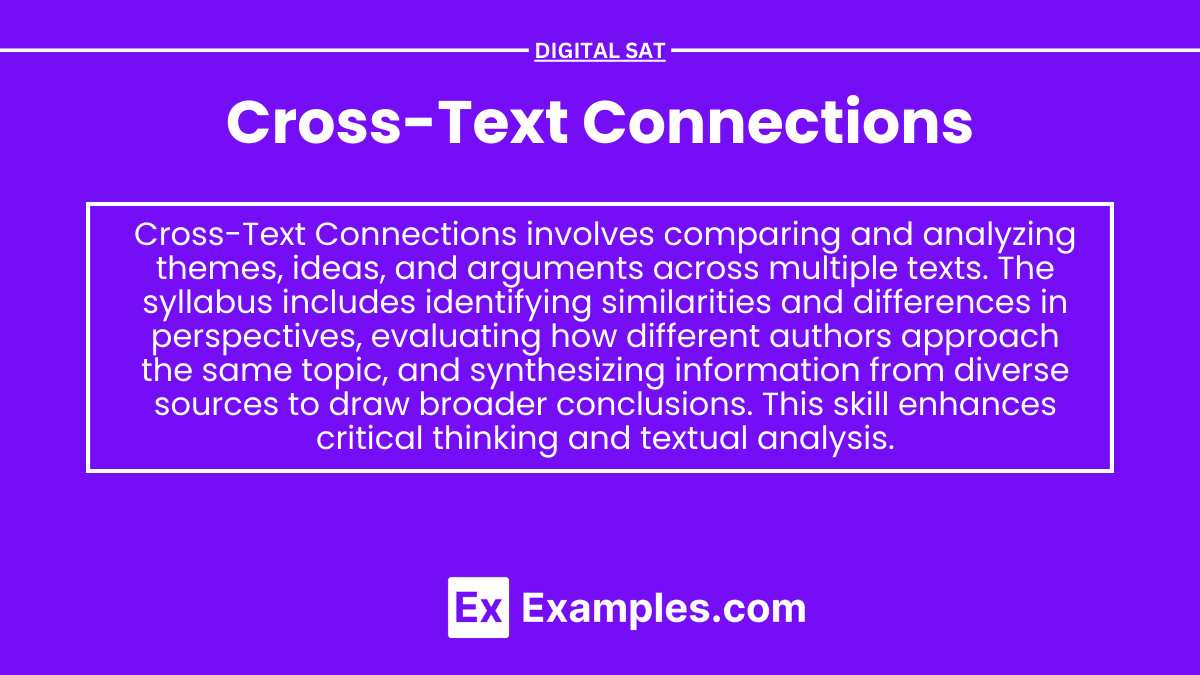Cross-Text Connections on the Digital SAT are designed to assess your ability to analyze, compare, and integrate information across multiple texts. These questions test how well you can discern relationships between two or more passages, and they require you to draw connections between themes, perspectives, evidence, and arguments presented in each text. Excelling at Cross-Text Connections demands careful reading, critical thinking, and the ability to synthesize information across different sources.
Learning Objectives
In studying “Cross-Text Connections” for the Digital SAT, you should learn to identify relationships between two or more texts, including similarities and differences in themes, arguments, and perspectives. Analyze how different authors present their ideas, use evidence, and address similar issues. Evaluate how texts build on or challenge each other’s ideas, and understand how comparing and contrasting texts deepens comprehension. Additionally, practice making inferences and drawing connections that enhance your critical reading and analytical skills across multiple passages.
1. Identify Common Themes or Central Ideas

The first step in answering Cross-Text Connections questions is to identify the overarching themes or central ideas in each passage. Typically, the texts will share a common subject matter but present it from different angles, perspectives, or contexts. The goal is to:
- Pinpoint the main idea or argument of each passage.
- Determine how each author approaches the topic. Are they in agreement, or do they present contrasting perspectives?
- Look for clues in the title, introduction, and conclusion of each passage to grasp the central message.
For example, if two passages discuss climate change, one might focus on scientific data, while the other could present a political or ethical perspective. Understanding the similarities and differences in how the topic is treated is key to finding connections.
2. Analyze Author’s Tone and Purpose
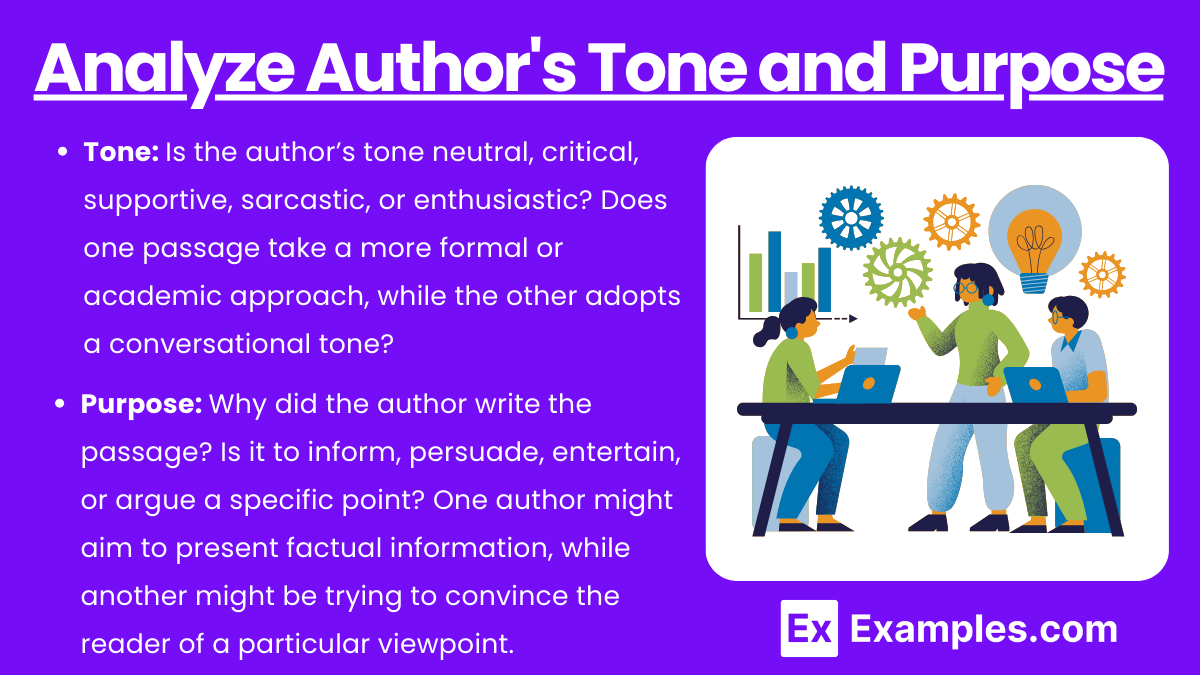
Each author writes with a particular tone and purpose, which can greatly influence how they present their arguments or ideas. Recognizing these elements helps you understand the relationship between the texts. When analyzing tone and purpose, consider:
- Tone: Is the author’s tone neutral, critical, supportive, sarcastic, or enthusiastic? Does one passage take a more formal or academic approach, while the other adopts a conversational tone?
- Purpose: Why did the author write the passage? Is it to inform, persuade, entertain, or argue a specific point? One author might aim to present factual information, while another might be trying to convince the reader of a particular viewpoint.
Understanding the tone and purpose provides context for how the authors’ views align or diverge. For instance, two passages on environmental conservation might share similar factual information, but one could be urging immediate action, while the other advocates for a more cautious approach.
3. Evaluate the Use of Evidence and Supporting Details
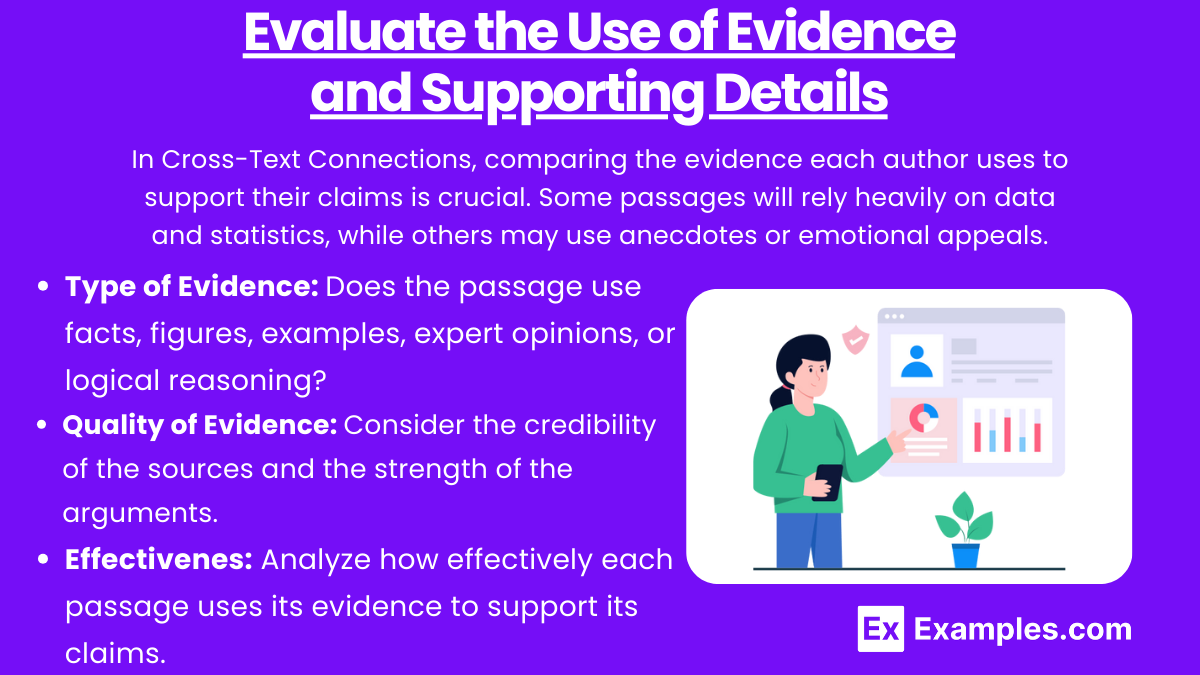
In Cross-Text Connections, comparing the evidence each author uses to support their claims is crucial. Some passages will rely heavily on data and statistics, while others may use anecdotes or emotional appeals. As you read, pay attention to:
- Type of Evidence: Does the passage use facts, figures, examples, expert opinions, or logical reasoning? Is the evidence presented in a formal or informal manner?
- Quality of Evidence: Consider the credibility of the sources and the strength of the arguments. Does one passage provide stronger, more convincing evidence than the other?
- Effectiveness: Analyze how effectively each passage uses its evidence to support its claims. Does the evidence enhance the argument, or does it seem weak or irrelevant?
When comparing two texts, ask yourself whether one uses more robust or persuasive evidence than the other. For example, one passage on the benefits of renewable energy might present hard data from scientific studies, while the other could rely on personal experiences and opinions.
4. Understand the Relationships Between Texts
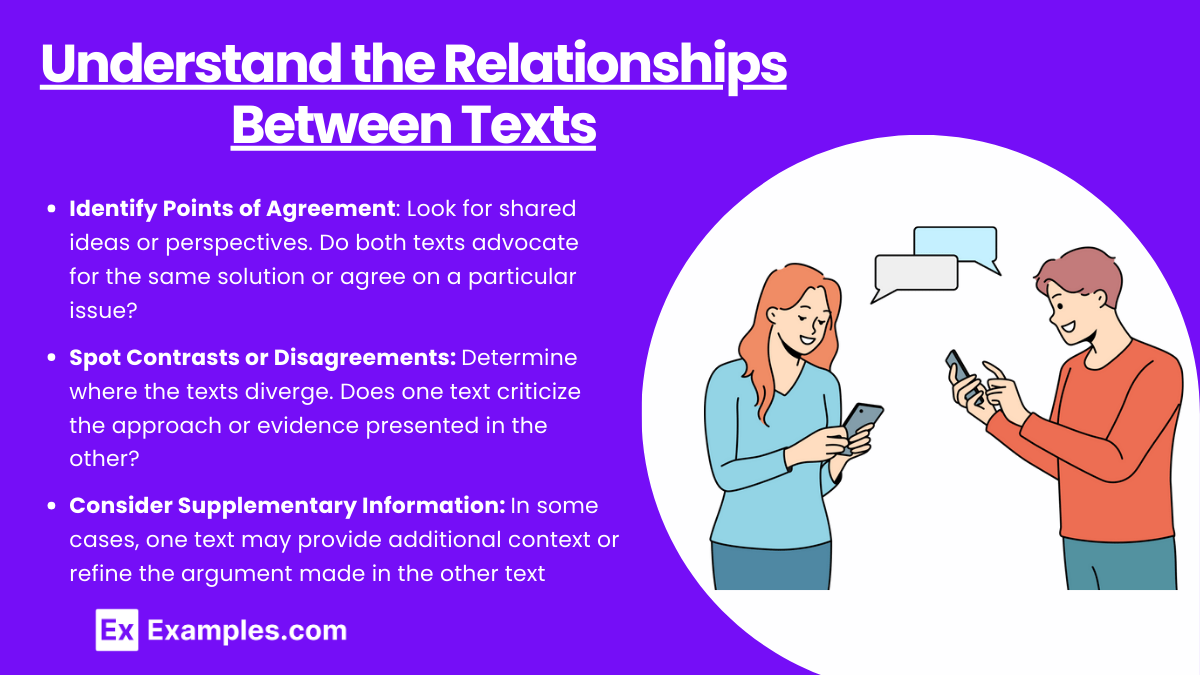
Cross-Text Connections questions often require you to understand how the texts relate to one another. Sometimes the relationship is complementary, where both texts support a similar idea, while other times the texts may take opposing stances. To effectively analyze these relationships, you should:
- Identify Points of Agreement: Look for shared ideas or perspectives. Do both texts advocate for the same solution or agree on a particular issue?
- Spot Contrasts or Disagreements: Determine where the texts diverge. Does one text criticize the approach or evidence presented in the other? Is there a fundamental disagreement in their conclusions?
- Consider Supplementary Information: In some cases, one text may provide additional context or refine the argument made in the other text, helping to broaden your understanding of the topic.
5. Synthesize Information Across Texts
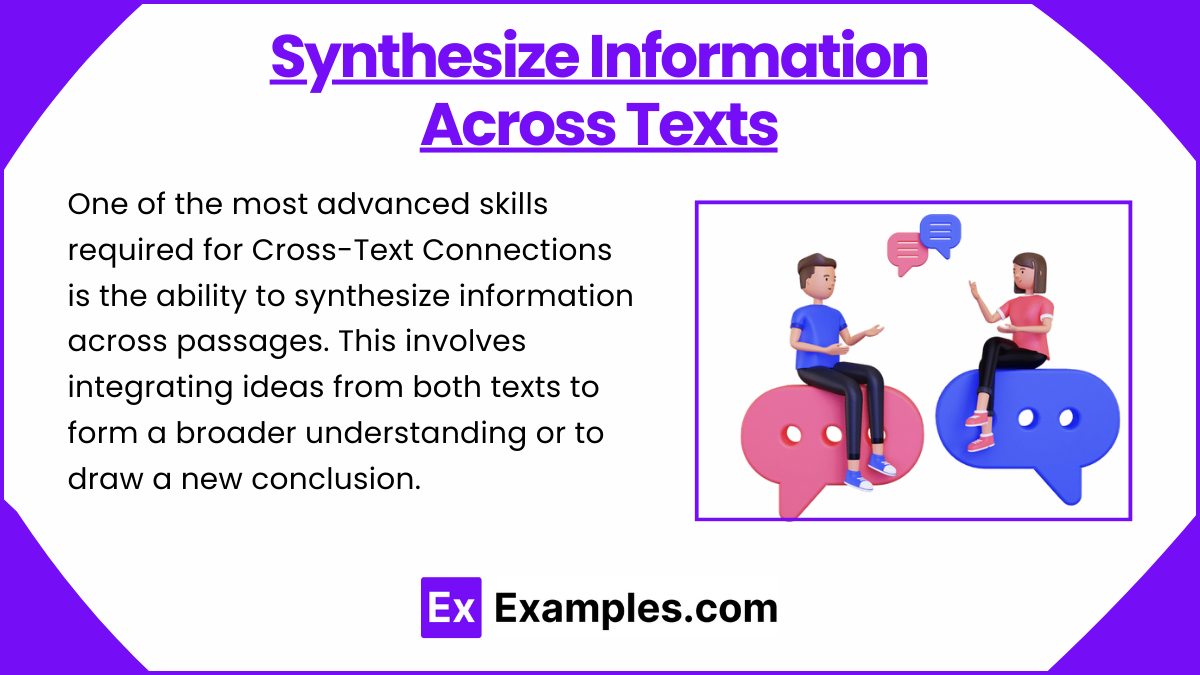
One of the most advanced skills required for Cross-Text Connections is the ability to synthesize information across passages. This involves integrating ideas from both texts to form a broader understanding or to draw a new conclusion. To do this, you should:
- Combine Key Ideas: Bring together the main points from each passage to create a more comprehensive view of the topic.
- Draw New Conclusions: Based on the comparison, ask yourself what new insights you can gain from evaluating both perspectives together.
- Find Larger Implications: Consider what the combined information from both texts tells you about the subject at hand. What broader themes or lessons can be learned?
Examples
Example 1: Technology and Privacy
Passage 1 discusses the benefits of increased technological surveillance in public spaces, arguing that it leads to greater security and helps law enforcement prevent crimes. Passage 2, however, takes a critical view of such surveillance, stating that it infringes on personal privacy and leads to potential misuse of data by government and private entities. You would need to compare how both passages address the balance between security and privacy, with one focusing on the positive impacts of safety and the other raising ethical concerns about individual freedom.
Example 2: Climate Change Solutions
Passage 1 supports the use of renewable energy sources, such as solar and wind power, as the best long-term solution to combat climate change. It highlights the sustainability and environmental benefits of these energy sources. Passage 2, however, argues that while renewable energy is important, nuclear energy should also be considered a crucial part of the solution due to its ability to produce large amounts of energy with minimal emissions. You would examine how each passage prioritizes different energy solutions, with one emphasizing the eco-friendliness of renewables and the other advocating for the inclusion of nuclear energy for its efficiency.
Example 3: The Role of Arts in Education
Passage 1 argues that the arts, such as music, painting, and theater, are essential to a well-rounded education because they foster creativity, critical thinking, and emotional intelligence in students. Passage 2, however, claims that while arts education has value, schools should prioritize STEM subjects (Science, Technology, Engineering, and Math) to better prepare students for the job market and the challenges of a technology-driven world. Here, the connection would involve contrasting how the passages define the purpose of education, with one emphasizing personal growth through the arts and the other focusing on practical job skills through STEM.
Example 4: Historical Perspectives on Colonialism
Passage 1 takes a critical stance on colonialism, discussing its long-lasting negative impacts on indigenous populations, including cultural erasure, economic exploitation, and social inequality. Passage 2, however, acknowledges the harms of colonialism but highlights some of the positive legacies, such as the introduction of modern infrastructure, legal systems, and global trade networks. In this case, you would need to analyze the different perspectives, with one passage focusing on the destructive nature of colonialism and the other recognizing both positive and negative consequences.
Example 5: The Ethics of Artificial Intelligence (AI)
Passage 1 argues that AI is a groundbreaking technology that has the potential to revolutionize industries, improve healthcare, and increase productivity. It discusses how AI can take over repetitive tasks, allowing humans to focus on more creative and complex problems. Passage 2, on the other hand, warns of the dangers of AI, including job displacement, loss of privacy, and the potential for AI systems to make biased or unethical decisions. The connection here would involve comparing the optimistic view of AI’s benefits with the cautionary approach that emphasizes ethical concerns and risks.
Practice Questions
Question 1:
Passage 1 argues that social media has revolutionized the way people connect with one another by fostering global communication and collaboration, allowing individuals from different parts of the world to share ideas, work together, and build relationships. Passage 2, however, suggests that social media platforms have contributed to increased feelings of isolation and anxiety, as people become more absorbed in their online personas and disengage from real-world interactions.
Which of the following best describes the relationship between the two passages?
A) Passage 1 and Passage 2 both emphasize the positive effects of social media on human relationships.
B) Passage 1 and Passage 2 take contrasting views on the impact of social media on human relationships.
C) Passage 2 refutes the claims made in Passage 1 by providing counter-evidence.
D) Passage 1 provides a historical context for social media, while Passage 2 focuses on its psychological effects.
Correct Answer: B) Passage 1 and Passage 2 take contrasting views on the impact of social media on human relationships.
Explanation: Passage 1 highlights the positive impact of social media on fostering global communication and relationships, while Passage 2 presents a contrasting perspective by focusing on the negative psychological effects, such as isolation and anxiety. The key to this question is recognizing that both passages address the same topic but with opposing viewpoints. Thus, the correct answer is B, as the passages present contrasting views on the effects of social media.
Question 2:
Passage 1 discusses the potential of renewable energy, such as solar and wind, to significantly reduce carbon emissions and combat climate change. The passage highlights how these sources are sustainable and increasingly cost-effective. Passage 2 argues that while renewable energy is essential, it alone cannot meet global energy demands, and nuclear energy must also be considered due to its high efficiency and low carbon emissions.
Which of the following best summarizes the connection between the two passages?
A) Both passages argue that renewable energy is the only solution to climate change.
B) Passage 2 completely contradicts the points made in Passage 1.
C) Passage 1 emphasizes the advantages of renewable energy, while Passage 2 suggests that other energy sources are also necessary.
D) Passage 1 focuses on environmental concerns, while Passage 2 focuses on economic considerations.
Answer: C) Passage 1 emphasizes the advantages of renewable energy, while Passage 2 suggests that other energy sources are also necessary.
Explanation: Passage 1 strongly advocates for the use of renewable energy to combat climate change, while Passage 2 acknowledges the importance of renewable energy but suggests that it must be used in conjunction with other energy sources like nuclear power to meet global energy needs. Both passages are concerned with addressing climate change, but Passage 2 extends the argument by adding nuclear energy to the mix. Thus, the correct answer is B, which highlights how the passages are connected through their focus on energy solutions but differ in their scope.
Question 3:
Passage 1 argues that space exploration is essential for the future of humanity, as it can lead to scientific advancements, new resources, and potential colonization of other planets. Passage 2, however, contends that the vast amount of money spent on space exploration could be better allocated to solving pressing issues on Earth, such as poverty, hunger, and environmental degradation.
Which of the following best describes how the two passages address the topic of space exploration?
A) Both passages agree that space exploration is necessary, but for different reasons.
B) Passage 2 refutes the idea that space exploration should be prioritized over other global concerns.
C) Passage 1 provides data to support space exploration, while Passage 2 focuses only on philosophical arguments.
D) Passage 1 and Passage 2 present complementary arguments about the importance of space exploration.
Correct Answer: B) Passage 2 refutes the idea that space exploration should be prioritized over other global concerns.
Explanation: Passage 1 emphasizes the long-term benefits of space exploration for the future of humanity, while Passage 2 questions the prioritization of space exploration over addressing immediate global issues such as poverty and environmental challenges. Passage 2 does not fully refute the idea of space exploration but argues that resources should be focused on more pressing matters. The correct answer is B, as Passage 2 presents a counter-argument to Passage 1’s emphasis on space exploration.

